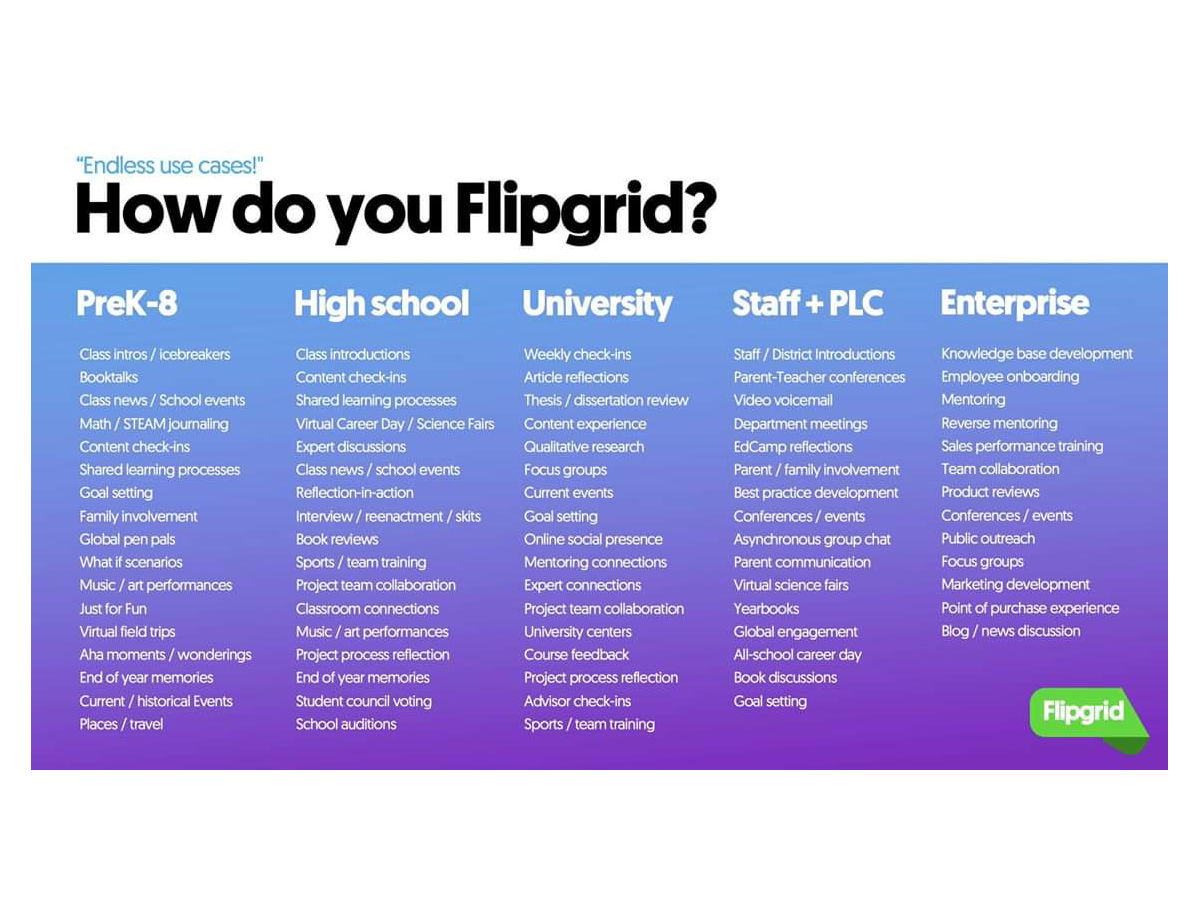
How To Use Flip In The Classroom
by TeachThought Staff
We’ve shared How To Use Flip (formely FlipGrid) in the past.
In this post, we’re sharing a graphic from Flip that provides ideas for using Flip in the classroom for every grade level. In a post by Terry Heick on viewing comprehension strategies, he talked about how video and text are similar–and not similar.
Like reading a text, video comprehension is a matter of decoding, but with different symbols based on unique modalities. Light, sound effects, scene cuts, dialogue, voice-overs, video speed, music, and more. How should students ‘approach’ a video? How should they watch one? What should they do when they’re done? More largely, what viewing comprehension strategies should students use to promote close viewing? What can they do to increase comprehension and retention of video content so that they are able to repackage meaning into other media forms?
One takeaway is that video can be used as a surrogate for writing and a supplement to ‘speaking’ and real-time, in-class presentations. Short, easy-to-create-and-share video isn’t hugely different than short, easy-to-create-and-share writing–useful for assessment, collaboration, reflection, goal-setting, connecting with communities, and more. Moreover, Flip attempts to make it easy to limit who can view (in contrast to larger social media sites where such controls may not be as functional or obvious or elegant), making it a better fit in many cases for students, teachers, and schools.
See also Strategies For Using TikTok In The Classroom
So here are 40 ideas for using Flip in the classroom, separated by pre-K through 8, High School, and College/University. One way to think of it is not so much as ‘using Flip’ but ‘ideas for the kinds of things students can document and share with short videos.’ Below is a list to get this kind of thinking started, from Flip themselves and modified slightly for clarity and fit by TeachThought.
40 Ideas For Using FlipGrid In The Classroom
Ideas For Using FlipGrid In Pre-K through 8th Grade
1. Class Intros/Icebreakers
2. Booktalks
3. Class news/school events
4. Math/ STEAM journaling
5. Content check-ins
6. Shared learning processes
7. Goal setting
8. Family involvement
9. Global pen pals
10. ‘What if?’ scenarios
11. Music/Art performances
12. Just for fun!
14. ‘Aha moments’ or ‘wonderings’
15. End of year memories
16. Current or istorical events
17. Travel reflections
Ideas For Using FlipGrid In High School
18. Class introductions
19. Content check-ins
20. Shared learning processes
21. Virtual Career Day or Science Fairs
22. Expert discussions
23. Class news or schools events
25. Interviews, re-enactments, or dramatic skits
26. Book reviews
27. Sports evaluation and training
28. Music, artistic, or dramatic performances
29. Project-based learning reflection during or after the project
30. End of year memories
31. Student government voting
32. Auditions and tryouts
Ideas For Using FlipGrid In College/University
33. Weekly check-ins with instructors, students, group members, etc.
35. Thesis brainstorming, practice, or review
36. Content experience
37. Qualitative research
38. Focus groups
39. Current event reflection, summary, skimming, survey, or review
40. Goal setting
40 Ideas For Using FlipGrid In The Classroom
